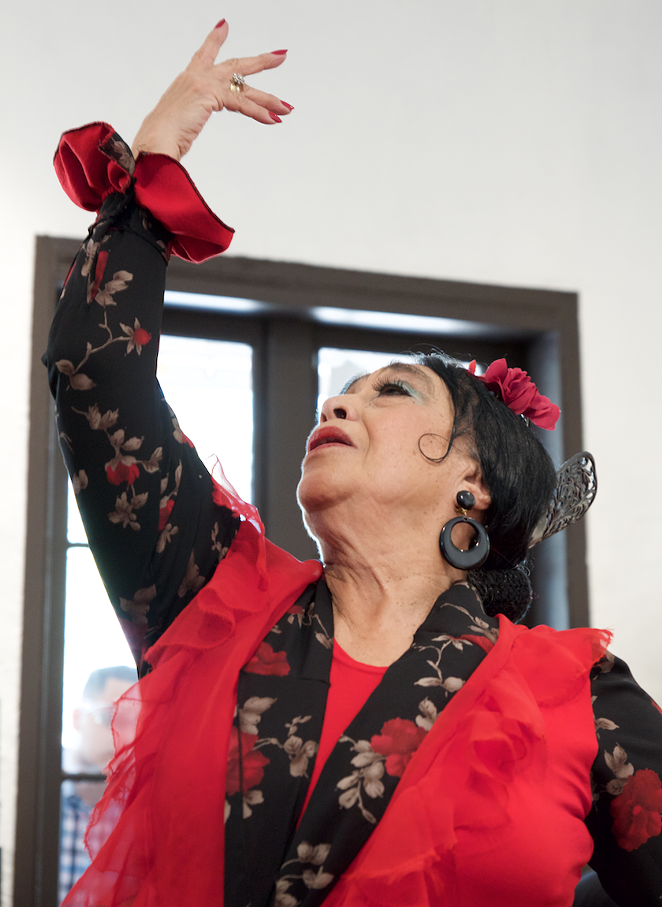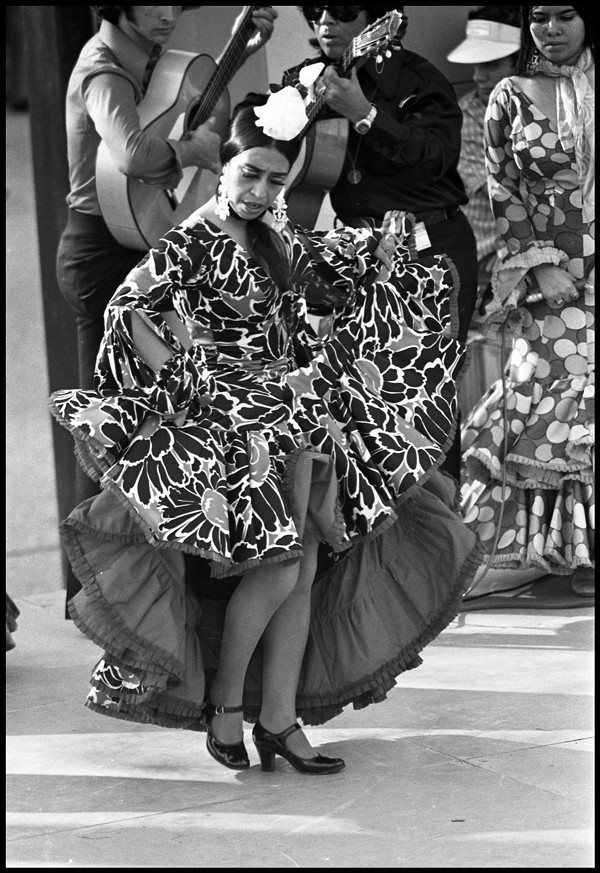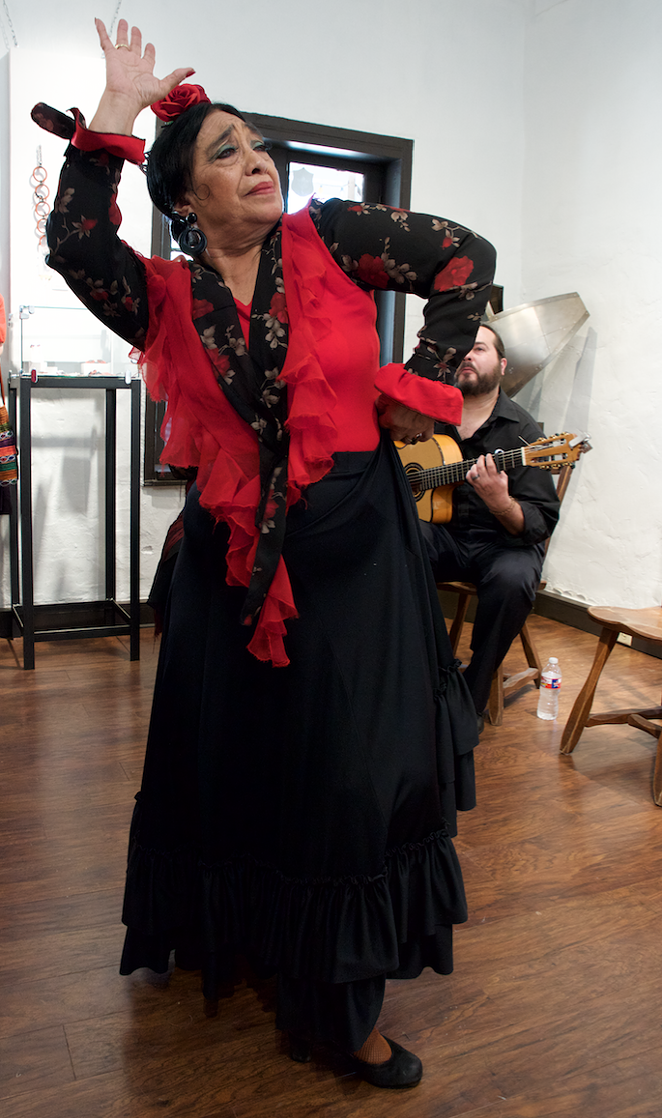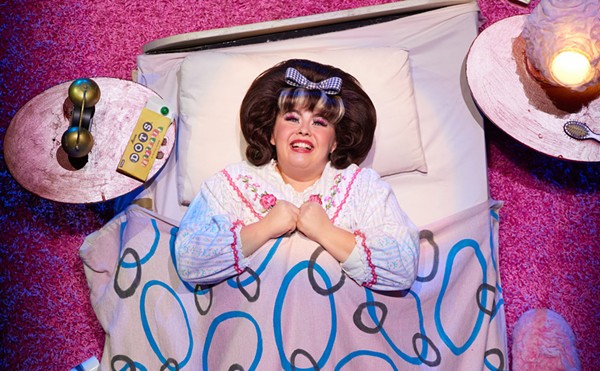In celebration of her 80th birthday, the ninth annual We Flamenco Fest will kick off its festivities with a tribute to Teresa Champion on October 4 at the Little Carver Civic Center. Then, on October 20, the Champion family will perform as part of this year’s Una Noche en la Gloria at the Guadalupe Theater.
I first became acquainted with flamenco in the early 2000s at Carmens de la Calle when it was located on Mistletoe off the St. Mary’s Strip. Back then, dancer Jackie “La Morena” Rodriguez and guitarist Alejandro Herrera would fill the small cafe to capacity with their explosive flamenco performances. La Morena would wow the audience by dancing on a small wooden platform while Herrera matched her abilities on guitar. The crowds would go wild. It was a scene not unlike the one in The Alamo. Of course, I had yet to see the film, but I knew then that I wanted to learn about the roots of flamenco in this city and how it all began.
Certainly, the San Antonio dance community has been shaped by many important figures throughout the past century. Beginning in the 1930s, Berta Almaguer would help bring Spanish dance and folklórico to the city’s Parks and Recreation Department. Nelda Drury taught at San Antonio College and founded the annual Folk Dance Festival. And, of course, Carmen “La Chiqui” Linares has played a key role within the local flamenco community (Linares will be honored on Saturday during We Flamenco Fest at the Carver’s Jo Long Theatre). But it was always Champion who, at least for me, remained an elusive, almost larger-than-life figure. Aside from a few chance encounters at local flamenco shows, I never had a conversation with Champion, until recently, when we met at her studio located near South Flores Street on the city’s South Side. There, the walls of her studio are filled with memorabilia and awards representing several decades of her career in flamenco. Outside, a large mural depicting Champion’s face covers one of the walls.
An old art form with origins in the mountainous region of Andalusia in southern Spain, the art of flamenco incorporates Indian, Moorish and Jewish traditions. In its purest forms, it is accompanied by guitar (toque) and singing (cante). In the 20th and 21st century, flamenco became a global phenomenon.
“In 1954, I was the first lady to bring flamenco to San Antonio,” Champion told the Current.
As a child, she went to Mexico City to learn how to dance folklórico in hopes of becoming a folklórico teacher. But after being there only one month, she heard the flamenco guitar and told her mother she wanted to learn flamenco instead. She returned to San Antonio and began performing at various nightclubs throughout the city.
“I was a professional dancer at 12 years old but I didn’t have a guitarist,” Champion said. “My mother was very smart. She was going to make sure that nothing was going to stop my career or take me away from her.”
One night at the Cuban Dinner Club, where Champion would become a regular dancer, her mother noticed El Curro, then a teenager, playing guitar for a Mexican trio called Los Crystales. She decided to ask if he would play for Teresa and bought him a record by the famous flamenco guitarist Sabicas.
“Mira, Mr. Willie,” Champion’s mother told the guitarist. “Le voy a dar este disco. Apréndelo ... learn it, please … so you can play for my daughter. We spent a lot of money on flamenco but she cannot use it because we don’t have a guitarist.”
For months after, and to no avail, Champion’s mother would ask El Curro if he learned to play anything off the record. One day, he finally said, “Yes, I learned one song.” She immediately called the owner of the Cuban Dinner Club and set up a gig for the two young musicians.
“I danced and we had a standing ovation,” Champion said. El Curro would continue to learn the flamenco guitar.
At the age of 16, Champion and El Curro, who was six years older, became a couple. The two were married for 57 years until El Curro passed away in 2012.
“We were in show business 100 percent,” Champion said. “All he did was play the guitar and all I did was teach and dance. Some dancers right now — they are nurses, secretaries, teachers. We were solely show business. We bought our home with the art. We bought our cars and supported our kids through the art.”
In 1959, when El Curro was selected to perform in The Alamo, he insisted that Champion visit the set with him. Champion, who did not audition for any of the dancer roles, says she was selected when the director first laid eyes on her. “When John Wayne saw me, he came straight to me,” she said. “I thought he was going to throw me out because I had no business there … He came very close to me and said ‘What do you do?’ I said ‘I’m a dancer and I’m here with my husband the guitarist. I’m here because I wanted to see you.”
As Champion claims, Wayne turned to the casting director and insisted that she play the role of the flamenco dancer on the table. “I don’t know what it was,” Champion said. “Maybe he liked my face … I don’t know … maybe it was just my time.”
When the day of filming came, Champion realized she had a problem.
“I told my husband Curro, ‘I’m afraid of heights, I don’t think I can dance,” she said. “He turned around and said, ‘Teresa, do you want to live in the Cassiano Courts all your life or do you want a house?’ I said ‘I want a house.’ John Wayne picked me up by the waist and put me on the table. I made sure that it was one take because I was scared!”
In the decades that followed, the Champions would tour the world with the famous flamenco dancer Jose Greco and would become mainstays on the River Walk, performing at the Alamo Kiwanis Club’s Fiesta Noche del Rio at the Arneson River Theatre. Champion also taught flamenco classes with Ballet Folklórico de San Antonio for 12 years before establishing her own studio. El Curro played guitar at Las Canarias restaurant inside La Mansión del Rio for nearly 40 years.
“He taught a lot of boys [how to play guitar],” Champion said. “A lot of them left to play somewhere else … Alejandro Herrera took classes with him. Steve Arispe … At Carmens de la Calle, I start to cry because there are too many memories.”
When El Curro fell ill in 2012, the family called upon guitarist Christopher Arispe (who also considers Curro a mentor) to fill in at Las Canarias. “We asked if he could play for two weeks,” Champion said. “He’s still there today. He’s been there six years, two months.”
“In the beginning, it was hard,” Arispe told the Current during a phone interview. “It was a tough situation. I was there because I was taking the place of Curro, who had been there for so long. A lot of people that frequented the restaurant when he was there would come and say to me, ‘You don’t play like Curro.’ It took a little bit of patience on my part to understand that they had lost a beloved person who crossed their life.”
Although he doesn’t feel the pressure to play like El Curro as much today, Arispe says many visitors to the restaurant still share their memories of the Champions. He understands the impact the couple has had on the community. “When you think of flamenco in San Antonio and South Texas, the first people you think of are the Champions,” he said. “Teresa and Curro are, I believe, the first ones to establish that here. She passed on what she learned in Mexico to just about every dancer who’s ever performed in San Antonio to countless other people.”
Among the many dancers who took classes with Champion is Jessica Ahr, who now dances with several flamenco troupes around the city. “She has inspired so many people because of the amount of time she has been here,” Ahr said. “There are countless numbers of people who have seen what she does, at some point in their life, and were inspired to do it themselves or put their kids into it, or grandkids, or simply want to be a part of it somehow.”
Aside from the generations of dancers who have studied under the Champions, the couple has passed on their love of the arts to their own children and grandchildren, several of whom have established their own careers in the world of flamenco. “She passed it down to her family,” Ahr continued. “It had a direct effect on her family. It supports them, it shapes them, it’s what they do. Her daughters do it for a living, her granddaughter has her master’s degree in dance because she has been inspired to go that way.”
“Teresa is a pioneer in the flamenco art … both of my parents were,” said Rosalinda “Chayito” Champion, a renowned flamenco vocalist in her own right. “She brought flamenco to San Antonio back in the 1950s. The dancers that you see now, because she’s in her third generation of teaching, all started with her. She was instrumental in inspiring young dancers to do flamenco and pursue it as a career.”
In November, Chayito is off to Germany along with Austin resident Oliver Rajamani to perform in the production Flamenco India. Of course, it will not be the first time the Champion influence has reached a global audience.
“When her students leave and go to Spain, they are told, ‘We pretty much know you come from Teresa because of your posture, your arm work and skirt work,’” Chayito said. “There is a style there that other teachers pick up on when her students go there.”
Among Champion’s students who have become international flamenco stars are Priscilla “La Prisci” Treviño and Timo Lozano. Tragically, both succumbed to various illnesses in the past decade and have since passed. Treviño was known for establishing a studio in Granada (a rare feat for a non-Spaniard) and also produced several well-known dancers. Lozano was known as “The King of Bulerías.” His workshops in Spain became so popular it was not uncommon to see lines of students wrapped around the buildings.
“Priscilla Treviño and Timo Lozano were my best students ever,” Champion said. “They made it in the world, in Europe, in New York … everywhere they went. They never forgot me. They would call me … they would write me every Mother’s Day … Pero... se los llevó la Muerte…”
“A lot of dancers make it a career and never come back to San Antonio,” Chayito said. “They stay in Spain or elsewhere and they don’t come back. She always stresses, ‘I know you’re leaving. You’re going to Spain to study, but come back. Don’t keep it from us because we can’t go there. When you’re out there, don’t forget who you are and where you come from, and come back and share what you’ve learned so that we can keep going here in San Antonio.’”
On Thursday, the flamenco community will gather to honor the life and work of Teresa Champion as part of this year’s We Flamenco Fest. Champion as well as three generations of students will perform at the event. Paula Sullivan, who owns Carmens de la Calle and has organized the festival since 2016, says she hopes the five-day event will help bring the dance community together. “Here is someone who has lived 80 years and has contributed to flamenco and other dance forms practically all her life,” she said. “I think we should celebrate her story.”
A Tribute to Teresa Champion
$20-$55, 7pm Thu, Oct. 4, Little Carver Civic Center, 226 N. Hackberry St., (210) 207-2234, thecarver.org.
Other highlights of We Flamenco Fest include Años de Inspiracion: A Tribute to Carmen Linares and Sonya Casillas ($20-$45, 8pm Sat, Oct. 6, Jo Long Theatre, 226 N. Hackberry) and the “En la Calle” outdoor festival (free, 5-10:30pm Sat, Oct. 12, Travis Park, 301 E. Travis St.). Visit facebook.com/weflamencofest for the complete schedule.
Stay on top of San Antonio news and views. Sign up for our Weekly Headlines Newsletter.




















